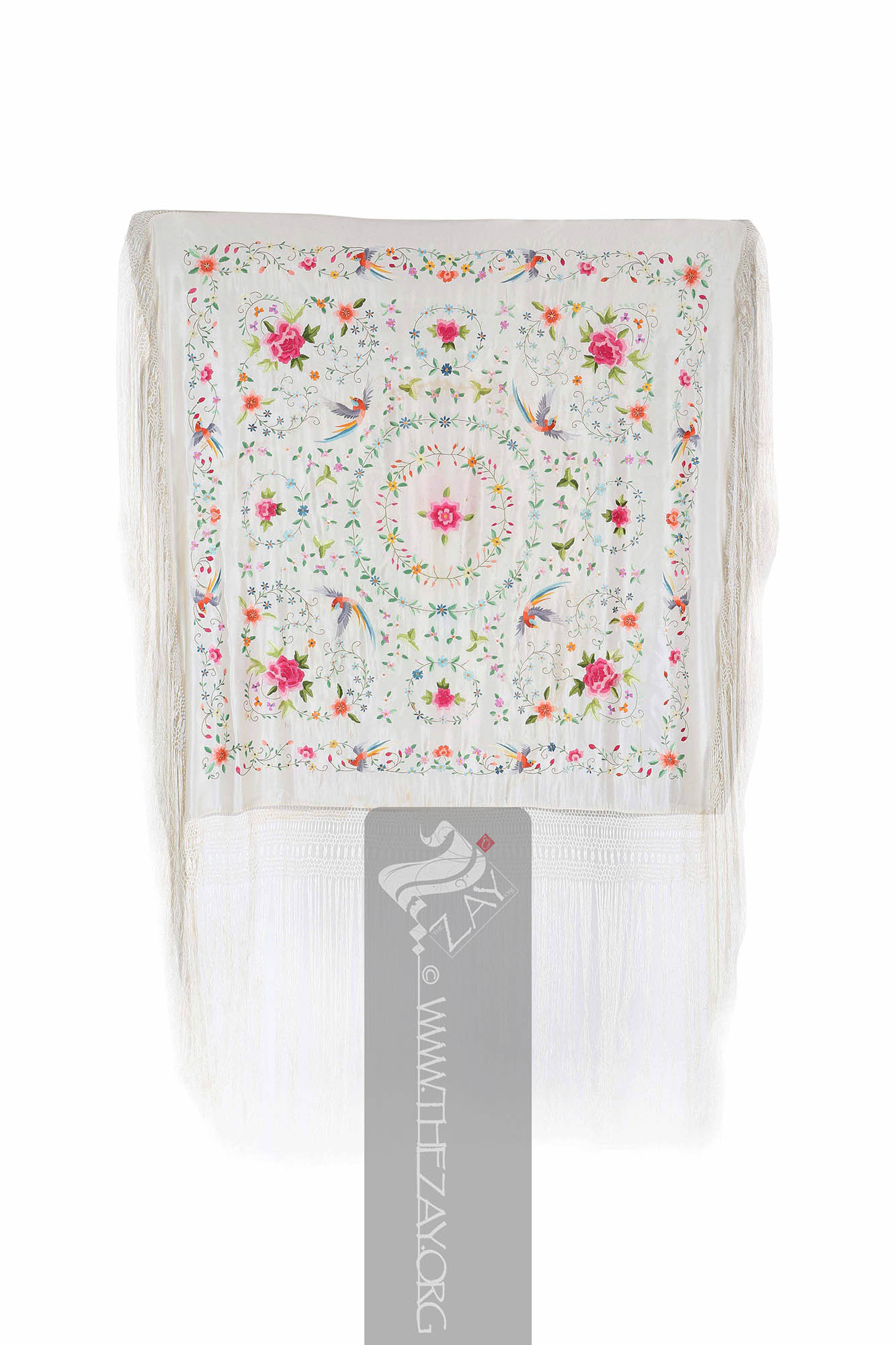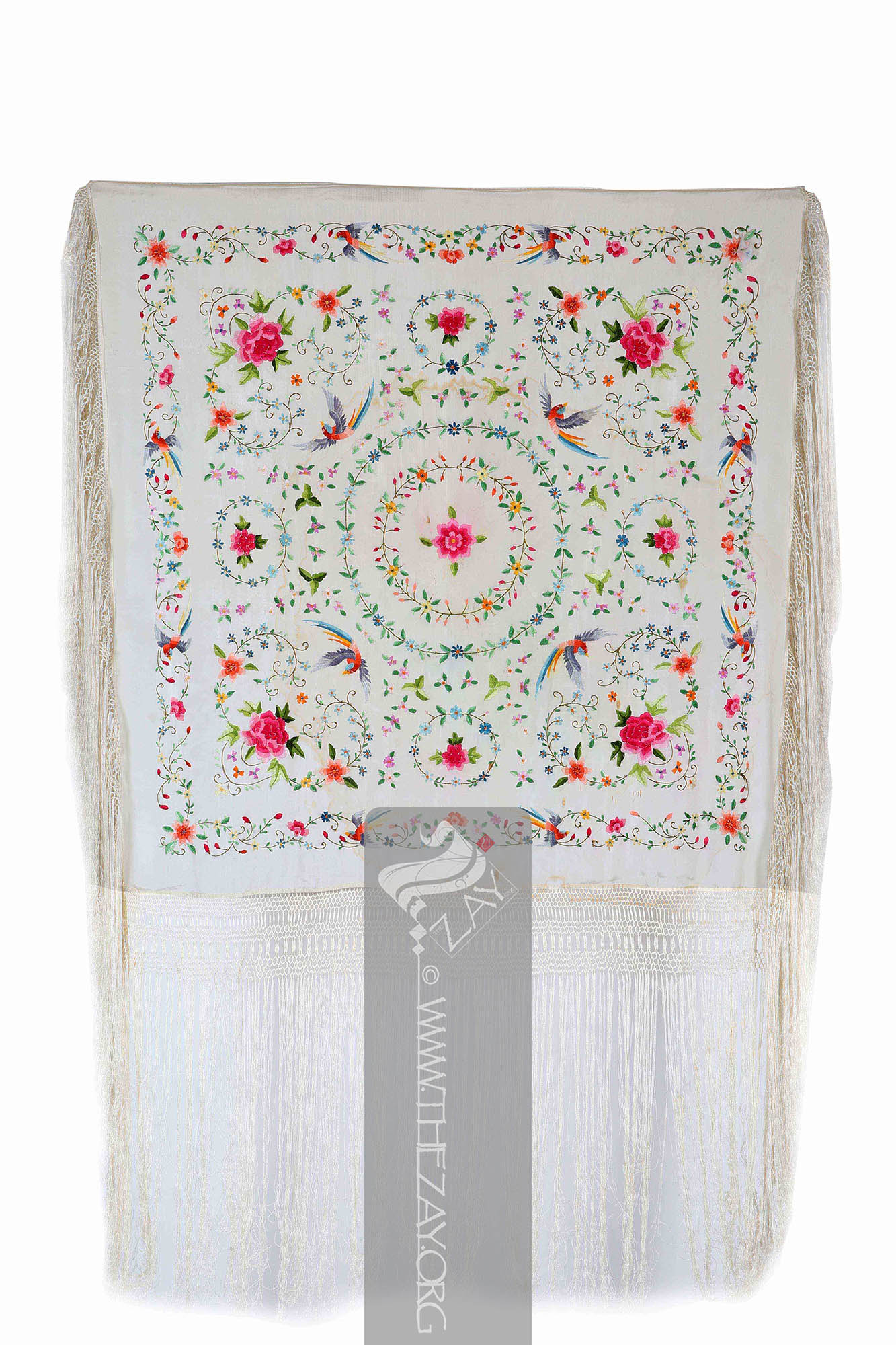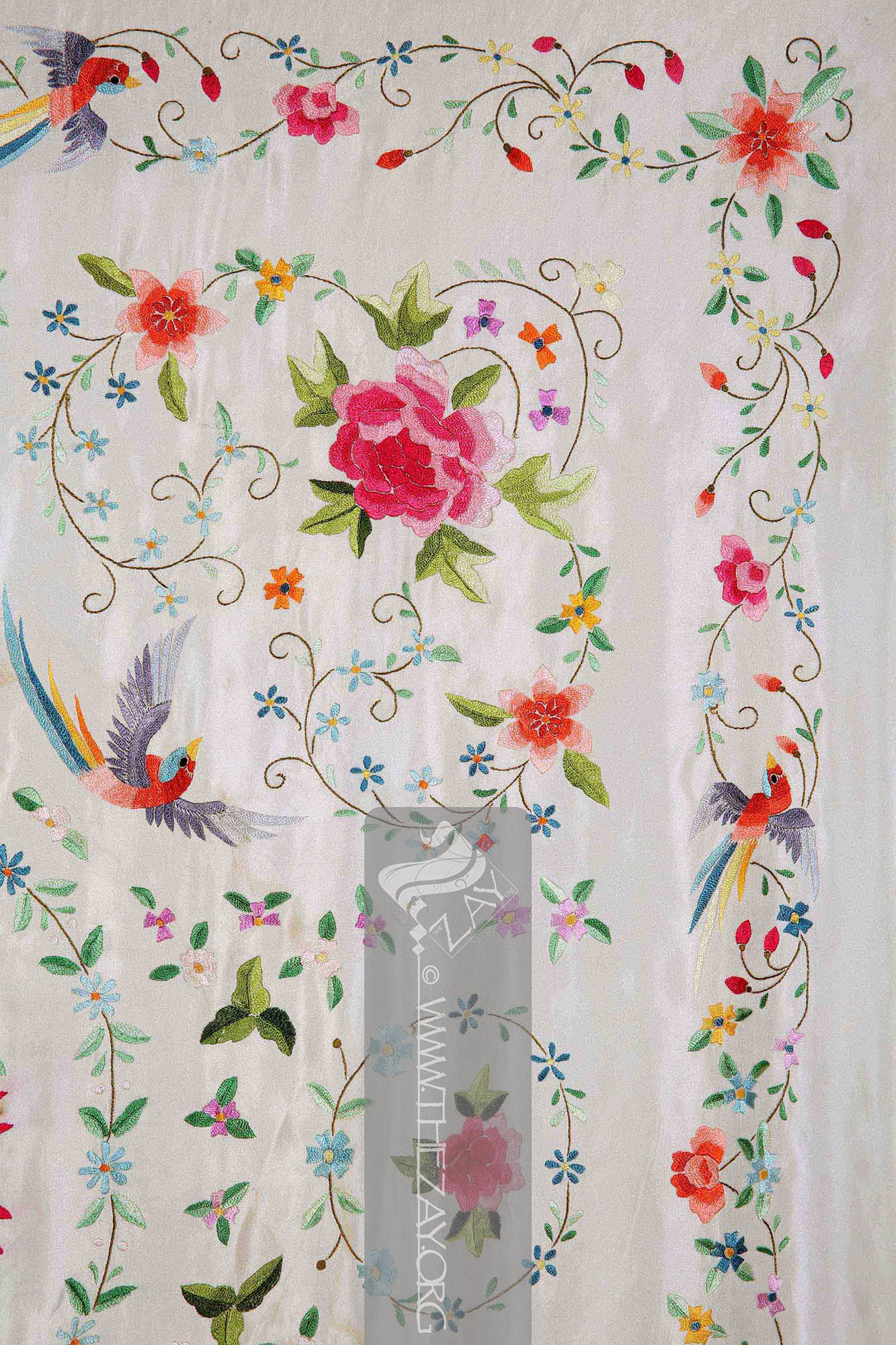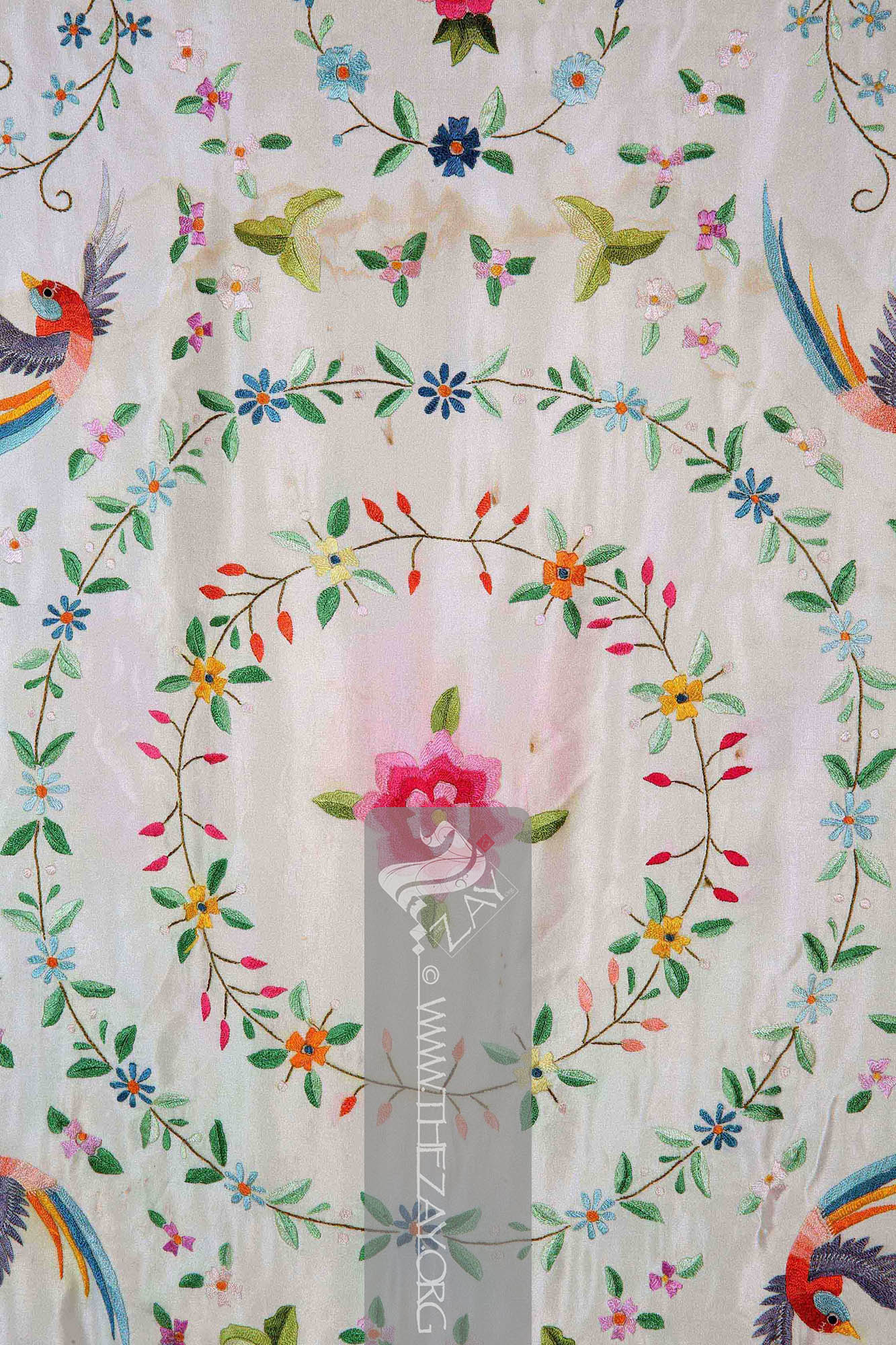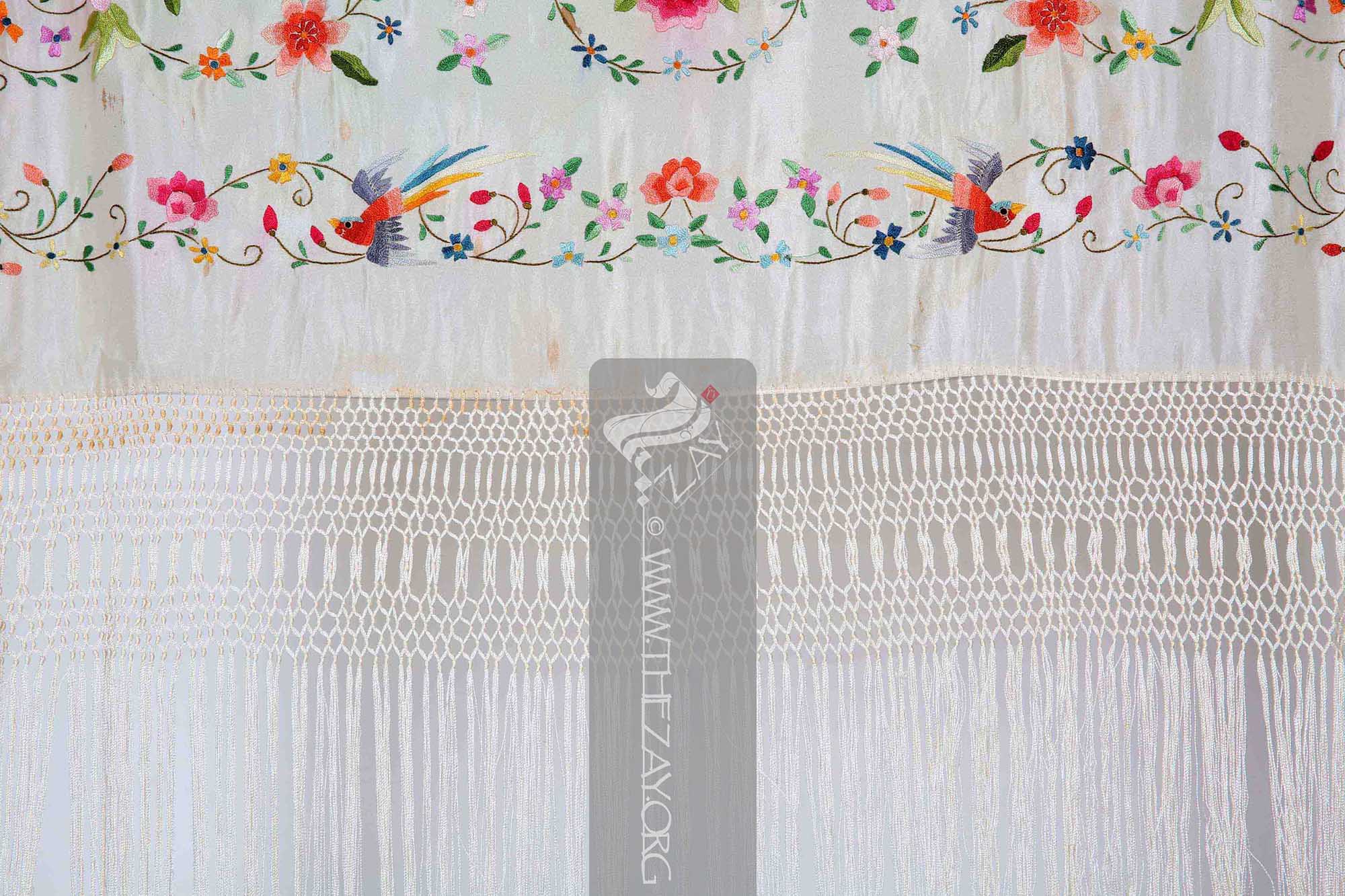Object History This
shawl
Shawl: (Persian: shāl from Hindi: duśālā – Shoulder Mantle), a shawl is a South Asian version of a scarf worn or wrapped loosely over the shoulders and is usually made of wool. was purchased in 1995 by Buthaina Al Kadi, mother of Dr Reem
Tariq
Ṭariq: (Arabic; Synonym: tulle_bi_talli
Tūlle_bi_tallī: (French: Tulle – a city in France where fine material for veil was first made; Turkish: tel – wire; Synonym: tariq; talli; badla; khus_dozi ), series of small metal knots made on a woven net ground as embellishment. The term is commonly used in the North African Arab region specifically in Egypt.
; talli; badla; khus_dozi ), series of small metal knots made on a woven net ground as embellishment. The term is commonly used in the Levant Arab region specifically in Lebanon.
El Mutwalli. It eventually became a part of The
Zay
Zay: (Arabic: costume, Pl. azyaā’), a set of clothes in a style typical of a particular country or historical period. Collection.
Object Features This square ivory silk (
shawl
Shawl: (Persian: shāl from Hindi: duśālā – Shoulder Mantle), a shawl is a South Asian version of a scarf worn or wrapped loosely over the shoulders and is usually made of wool. ) of (
satin
Sātin: (Arabic: Zaytuni: from Chinese port of Zayton in Quanzhou province where it was exported from and acquired by Arab merchants), one of the three basic types of woven fabric with a glossy top surface and a dull back. Originated in China and was fundamentally woven in silk.) weave, popularly known as (
Manila_shawl
Manila_shawl: (Manila: city in Philippines, synonyms: manton_de_seda
Manton_de_seda: (Spanish, mantón: shawl
Shawl: (Persian: shāl from Hindi: duśālā – Shoulder Mantle), a shawl is a South Asian version of a scarf worn or wrapped loosely over the shoulders and is usually made of wool. , de seda – of silk, synonyms: Canton_shawl, manila_shawl, Piano_shawl
Piano_shawl: (synonyms: manton_de_seda, Manila_shawl, Canton_shawl, manton_de_Manila) A silk embroidered shawl
Shawl: (Persian: shāl from Hindi: duśālā – Shoulder Mantle), a shawl is a South Asian version of a scarf worn or wrapped loosely over the shoulders and is usually made of wool. from Canton, China –Canton_shawl – introduced to the Manila, Philippines – a Spanish colony – through Spanish trade as it passed through its port. It became synonymous to flamenco costumes and Spanish identity and were also often draped over pianos thus Piano_Shawls., manton_de_Manila), a silk embroidered shawl
Shawl: (Persian: shāl from Hindi: duśālā – Shoulder Mantle), a shawl is a South Asian version of a scarf worn or wrapped loosely over the shoulders and is usually made of wool. from Canton, China introduced to the Manila, Philippines – a Spanish colony – through Spanish trade as it passed through its port. It became synonymous to flamenco costumes and Spanish identity and were also often draped over pianos thus Piano_Shawls., manton_de_Manila
Manton_de_Manila: (Spanish, mantón: shawl
Shawl: (Persian: shāl from Hindi: duśālā – Shoulder Mantle), a shawl is a South Asian version of a scarf worn or wrapped loosely over the shoulders and is usually made of wool. , synonyms: manton_de_seda
Manton_de_seda: (Spanish, mantón: shawl
Shawl: (Persian: shāl from Hindi: duśālā – Shoulder Mantle), a shawl is a South Asian version of a scarf worn or wrapped loosely over the shoulders and is usually made of wool. , de seda – of silk, synonyms: Canton_shawl, manila_shawl, Piano_shawl
Piano_shawl: (synonyms: manton_de_seda, Manila_shawl, Canton_shawl, manton_de_Manila) A silk embroidered shawl
Shawl: (Persian: shāl from Hindi: duśālā – Shoulder Mantle), a shawl is a South Asian version of a scarf worn or wrapped loosely over the shoulders and is usually made of wool. from Canton, China –Canton_shawl – introduced to the Manila, Philippines – a Spanish colony – through Spanish trade as it passed through its port. It became synonymous to flamenco costumes and Spanish identity and were also often draped over pianos thus Piano_Shawls., manton_de_Manila), a silk embroidered shawl
Shawl: (Persian: shāl from Hindi: duśālā – Shoulder Mantle), a shawl is a South Asian version of a scarf worn or wrapped loosely over the shoulders and is usually made of wool. from Canton, China introduced to the Manila, Philippines – a Spanish colony – through Spanish trade as it passed through its port. It became synonymous to flamenco costumes and Spanish identity and were also often draped over pianos thus Piano_Shawls., Piano_shawl
Piano_shawl: (synonyms: manton_de_seda, Manila_shawl, Canton_shawl, manton_de_Manila) A silk embroidered shawl
Shawl: (Persian: shāl from Hindi: duśālā – Shoulder Mantle), a shawl is a South Asian version of a scarf worn or wrapped loosely over the shoulders and is usually made of wool. from Canton, China –Canton_shawl – introduced to the Manila, Philippines – a Spanish colony – through Spanish trade as it passed through its port. It became synonymous to flamenco costumes and Spanish identity and were also often draped over pianos thus Piano_Shawls., manila_shawl, Canton_shawl), a silk embroidered shawl
Shawl: (Persian: shāl from Hindi: duśālā – Shoulder Mantle), a shawl is a South Asian version of a scarf worn or wrapped loosely over the shoulders and is usually made of wool. from Canton, China introduced to the Manila, Philippines – a Spanish colony – through Spanish trade as it passed through its port. It became synonymous to flamenco costumes and Spanish identity and were also often draped over pianos thus Piano_Shawls., Canton_shawl, Piano_shawl
Piano_shawl: (synonyms: manton_de_seda, Manila_shawl, Canton_shawl, manton_de_Manila) A silk embroidered shawl
Shawl: (Persian: shāl from Hindi: duśālā – Shoulder Mantle), a shawl is a South Asian version of a scarf worn or wrapped loosely over the shoulders and is usually made of wool. from Canton, China –Canton_shawl – introduced to the Manila, Philippines – a Spanish colony – through Spanish trade as it passed through its port. It became synonymous to flamenco costumes and Spanish identity and were also often draped over pianos thus Piano_Shawls.) A silk embroidered shawl
Shawl: (Persian: shāl from Hindi: duśālā – Shoulder Mantle), a shawl is a South Asian version of a scarf worn or wrapped loosely over the shoulders and is usually made of wool. from Canton, China –Canton_shawl – introduced to the Manila, Philippines – a Spanish colony – through Spanish trade as it passed through its port. It became synonymous to flamenco costumes and Spanish identity and were also often draped over pianos thus Piano_Shawls.) or (
Piano_shawl
Piano_shawl: (synonyms: manton_de_seda, Manila_shawl, Canton_shawl, manton_de_Manila) A silk embroidered shawl
Shawl: (Persian: shāl from Hindi: duśālā – Shoulder Mantle), a shawl is a South Asian version of a scarf worn or wrapped loosely over the shoulders and is usually made of wool. from Canton, China –Canton_shawl – introduced to the Manila, Philippines – a Spanish colony – through Spanish trade as it passed through its port. It became synonymous to flamenco costumes and Spanish identity and were also often draped over pianos thus Piano_Shawls.) or (
Canton_shawl
Canton_shawl: (Chinese: Ghuangzou: A city in Guangdong province, China, synonyms: manton_de_seda
Manton_de_seda: (Spanish, mantón: shawl
Shawl: (Persian: shāl from Hindi: duśālā – Shoulder Mantle), a shawl is a South Asian version of a scarf worn or wrapped loosely over the shoulders and is usually made of wool. , de seda – of silk, synonyms: Canton_shawl, manila_shawl, Piano_shawl
Piano_shawl: (synonyms: manton_de_seda, Manila_shawl, Canton_shawl, manton_de_Manila) A silk embroidered shawl
Shawl: (Persian: shāl from Hindi: duśālā – Shoulder Mantle), a shawl is a South Asian version of a scarf worn or wrapped loosely over the shoulders and is usually made of wool. from Canton, China –Canton_shawl – introduced to the Manila, Philippines – a Spanish colony – through Spanish trade as it passed through its port. It became synonymous to flamenco costumes and Spanish identity and were also often draped over pianos thus Piano_Shawls., manton_de_Manila), a silk embroidered shawl
Shawl: (Persian: shāl from Hindi: duśālā – Shoulder Mantle), a shawl is a South Asian version of a scarf worn or wrapped loosely over the shoulders and is usually made of wool. from Canton, China introduced to the Manila, Philippines – a Spanish colony – through Spanish trade as it passed through its port. It became synonymous to flamenco costumes and Spanish identity and were also often draped over pianos thus Piano_Shawls., manila_shawl
Manila_shawl: (Manila: city in Philippines, synonyms: manton_de_seda
Manton_de_seda: (Spanish, mantón: shawl
Shawl: (Persian: shāl from Hindi: duśālā – Shoulder Mantle), a shawl is a South Asian version of a scarf worn or wrapped loosely over the shoulders and is usually made of wool. , de seda – of silk, synonyms: Canton_shawl, manila_shawl, Piano_shawl
Piano_shawl: (synonyms: manton_de_seda, Manila_shawl, Canton_shawl, manton_de_Manila) A silk embroidered shawl
Shawl: (Persian: shāl from Hindi: duśālā – Shoulder Mantle), a shawl is a South Asian version of a scarf worn or wrapped loosely over the shoulders and is usually made of wool. from Canton, China –Canton_shawl – introduced to the Manila, Philippines – a Spanish colony – through Spanish trade as it passed through its port. It became synonymous to flamenco costumes and Spanish identity and were also often draped over pianos thus Piano_Shawls., manton_de_Manila), a silk embroidered shawl
Shawl: (Persian: shāl from Hindi: duśālā – Shoulder Mantle), a shawl is a South Asian version of a scarf worn or wrapped loosely over the shoulders and is usually made of wool. from Canton, China introduced to the Manila, Philippines – a Spanish colony – through Spanish trade as it passed through its port. It became synonymous to flamenco costumes and Spanish identity and were also often draped over pianos thus Piano_Shawls., manton_de_Manila
Manton_de_Manila: (Spanish, mantón: shawl
Shawl: (Persian: shāl from Hindi: duśālā – Shoulder Mantle), a shawl is a South Asian version of a scarf worn or wrapped loosely over the shoulders and is usually made of wool. , synonyms: manton_de_seda
Manton_de_seda: (Spanish, mantón: shawl
Shawl: (Persian: shāl from Hindi: duśālā – Shoulder Mantle), a shawl is a South Asian version of a scarf worn or wrapped loosely over the shoulders and is usually made of wool. , de seda – of silk, synonyms: Canton_shawl, manila_shawl, Piano_shawl
Piano_shawl: (synonyms: manton_de_seda, Manila_shawl, Canton_shawl, manton_de_Manila) A silk embroidered shawl
Shawl: (Persian: shāl from Hindi: duśālā – Shoulder Mantle), a shawl is a South Asian version of a scarf worn or wrapped loosely over the shoulders and is usually made of wool. from Canton, China –Canton_shawl – introduced to the Manila, Philippines – a Spanish colony – through Spanish trade as it passed through its port. It became synonymous to flamenco costumes and Spanish identity and were also often draped over pianos thus Piano_Shawls., manton_de_Manila), a silk embroidered shawl
Shawl: (Persian: shāl from Hindi: duśālā – Shoulder Mantle), a shawl is a South Asian version of a scarf worn or wrapped loosely over the shoulders and is usually made of wool. from Canton, China introduced to the Manila, Philippines – a Spanish colony – through Spanish trade as it passed through its port. It became synonymous to flamenco costumes and Spanish identity and were also often draped over pianos thus Piano_Shawls., Piano_shawl
Piano_shawl: (synonyms: manton_de_seda, Manila_shawl, Canton_shawl, manton_de_Manila) A silk embroidered shawl
Shawl: (Persian: shāl from Hindi: duśālā – Shoulder Mantle), a shawl is a South Asian version of a scarf worn or wrapped loosely over the shoulders and is usually made of wool. from Canton, China –Canton_shawl – introduced to the Manila, Philippines – a Spanish colony – through Spanish trade as it passed through its port. It became synonymous to flamenco costumes and Spanish identity and were also often draped over pianos thus Piano_Shawls., manila_shawl, Canton_shawl), a silk embroidered shawl
Shawl: (Persian: shāl from Hindi: duśālā – Shoulder Mantle), a shawl is a South Asian version of a scarf worn or wrapped loosely over the shoulders and is usually made of wool. from Canton, China introduced to the Manila, Philippines – a Spanish colony – through Spanish trade as it passed through its port. It became synonymous to flamenco costumes and Spanish identity and were also often draped over pianos thus Piano_Shawls., Canton_shawl, Piano_shawl
Piano_shawl: (synonyms: manton_de_seda, Manila_shawl, Canton_shawl, manton_de_Manila) A silk embroidered shawl
Shawl: (Persian: shāl from Hindi: duśālā – Shoulder Mantle), a shawl is a South Asian version of a scarf worn or wrapped loosely over the shoulders and is usually made of wool. from Canton, China –Canton_shawl – introduced to the Manila, Philippines – a Spanish colony – through Spanish trade as it passed through its port. It became synonymous to flamenco costumes and Spanish identity and were also often draped over pianos thus Piano_Shawls.) A silk embroidered shawl
Shawl: (Persian: shāl from Hindi: duśālā – Shoulder Mantle), a shawl is a South Asian version of a scarf worn or wrapped loosely over the shoulders and is usually made of wool. from Canton, China –Canton_shawl – introduced to the Manila, Philippines – a Spanish colony – through Spanish trade as it passed through its port. It became synonymous to flamenco costumes and Spanish identity and were also often draped over pianos thus Piano_Shawls., Piano_shawl
Piano_shawl: (synonyms: manton_de_seda, Manila_shawl, Canton_shawl, manton_de_Manila) A silk embroidered shawl
Shawl: (Persian: shāl from Hindi: duśālā – Shoulder Mantle), a shawl is a South Asian version of a scarf worn or wrapped loosely over the shoulders and is usually made of wool. from Canton, China –Canton_shawl – introduced to the Manila, Philippines – a Spanish colony – through Spanish trade as it passed through its port. It became synonymous to flamenco costumes and Spanish identity and were also often draped over pianos thus Piano_Shawls., manton_de_Manila
Manton_de_Manila: (Spanish, mantón: shawl
Shawl: (Persian: shāl from Hindi: duśālā – Shoulder Mantle), a shawl is a South Asian version of a scarf worn or wrapped loosely over the shoulders and is usually made of wool. , synonyms: manton_de_seda
Manton_de_seda: (Spanish, mantón: shawl
Shawl: (Persian: shāl from Hindi: duśālā – Shoulder Mantle), a shawl is a South Asian version of a scarf worn or wrapped loosely over the shoulders and is usually made of wool. , de seda – of silk, synonyms: Canton_shawl, manila_shawl, Piano_shawl
Piano_shawl: (synonyms: manton_de_seda, Manila_shawl, Canton_shawl, manton_de_Manila) A silk embroidered shawl
Shawl: (Persian: shāl from Hindi: duśālā – Shoulder Mantle), a shawl is a South Asian version of a scarf worn or wrapped loosely over the shoulders and is usually made of wool. from Canton, China –Canton_shawl – introduced to the Manila, Philippines – a Spanish colony – through Spanish trade as it passed through its port. It became synonymous to flamenco costumes and Spanish identity and were also often draped over pianos thus Piano_Shawls., manton_de_Manila), a silk embroidered shawl
Shawl: (Persian: shāl from Hindi: duśālā – Shoulder Mantle), a shawl is a South Asian version of a scarf worn or wrapped loosely over the shoulders and is usually made of wool. from Canton, China introduced to the Manila, Philippines – a Spanish colony – through Spanish trade as it passed through its port. It became synonymous to flamenco costumes and Spanish identity and were also often draped over pianos thus Piano_Shawls., Piano_shawl
Piano_shawl: (synonyms: manton_de_seda, Manila_shawl, Canton_shawl, manton_de_Manila) A silk embroidered shawl
Shawl: (Persian: shāl from Hindi: duśālā – Shoulder Mantle), a shawl is a South Asian version of a scarf worn or wrapped loosely over the shoulders and is usually made of wool. from Canton, China –Canton_shawl – introduced to the Manila, Philippines – a Spanish colony – through Spanish trade as it passed through its port. It became synonymous to flamenco costumes and Spanish identity and were also often draped over pianos thus Piano_Shawls., manila_shawl, Canton_shawl), a silk embroidered shawl
Shawl: (Persian: shāl from Hindi: duśālā – Shoulder Mantle), a shawl is a South Asian version of a scarf worn or wrapped loosely over the shoulders and is usually made of wool. from Canton, China introduced to the Manila, Philippines – a Spanish colony – through Spanish trade as it passed through its port. It became synonymous to flamenco costumes and Spanish identity and were also often draped over pianos thus Piano_Shawls.), a silk embroidered shawl
Shawl: (Persian: shāl from Hindi: duśālā – Shoulder Mantle), a shawl is a South Asian version of a scarf worn or wrapped loosely over the shoulders and is usually made of wool. from Canton, China introduced to the Manila, Philippines – a Spanish colony – through Spanish trade as it passed through its port. It became synonymous to flamenco
Flamenco: (Spanish: falmenco – A form of music, song & dance) An art form steeped in the traditional folklores and music from Andalusia and the Iberian Peninsula especially of the Romani culture. costumes and Spanish identity and were also often draped over pianos thus Piano_Shawls.), is hand embroidered with silk threads in an array of bright colours. The art style is contemporary (
chinoiserie
Chinoiserie: (French: chinoiserie from French: chinois – Chinese) A European interpretation and imitation of oriental – Chinese and Far Eastern – art characterized through Chinese motifs and techniques in architecture, couture, and decorative arts from mid to late 17th Century onwards. It was easily adopted as a part of contemporary Rococo aesthetics. ) while the colours and motifs are of (
Moorish
Moorish: (noun: Moors – People of North Africa and Iberian Peninsula from Latin: mauri from ancient Greek: amouros – dark, or dim; a name designated to the Berber-speaking ethnic population of Mauritania, Northwest Africa, Iberian Peninsula, Sicily, and Malta) Christian Europeans coined it to identify the native Muslim inhabitants of this region. ) and/or Spanish influence.
The
shawl
Shawl: (Persian: shāl from Hindi: duśālā – Shoulder Mantle), a shawl is a South Asian version of a scarf worn or wrapped loosely over the shoulders and is usually made of wool. can be roughly divided in three parts – the outer border near the edges, the almost square arrangement in the body, and the final circular central pieces – two wreaths with a large rose flanked by four leaves. The rose in the centre is embroidered in different shades of pink while the leaves are in shades of green. This is surrounded by two wreaths. The inner wreath has different shades of pink buds and leaves in shades of green, which is punctuated with orange flowers, while the outer wreath is decorated with only leaves, again in several shades of green, punctuated with blue flowers.
The body arrangement is in two parts – a diamond-shaped arrangement punctuated with four flowers each in the centre of a wreath and four birds “in flight”, and four heart-shaped floral arrangements one in each corner – giving the body an overall square densely embroidered shape. The birds in vibrant shades of red, orange, and yellow with grey tails, resembling macaws are alternatively placed with smaller wreaths and flowers almost similar to the central arrangement in a floral surrounding. It is interesting to note that beside being an iconic exotic bird during Europe’s colonial period, macaws are not native to either North Africa or Mediterranean Europe. It is however native to Central and Latin Americas which were once Spanish colonies.
The outer border is a 15 cm wide square composed of an undulating central branch with floral patterns. With a rose adorning on each end the branch exhibits a third rose in the middle with two mirrored birds perched on it with open wings.
A 50 cm long intricate ivory (
macrame
Macrame: makrəˌmā: (Arabic: karam: tree with dangling grapes), ornamental fringe. The art of knotting cord or string in patterns to make decorative articles. Earliest recorded uses of macramé-style knots as decoration appeared in Babylonian and Assyrian carvings.Macrame
Macrame: makrəˌmā: (Arabic: karam: tree with dangling grapes), ornamental fringe. The art of knotting cord or string in patterns to make decorative articles. Earliest recorded uses of macramé-style knots as decoration appeared in Babylonian and Assyrian carvings.: (French: macramé – A hand-knotted textile from Turkish: makrama – table spread or towel, from Arabic: miqrama – bedspread possibly with knotted hanging fringes resembling dangling grapes or karam in Arabic) A form of textile or fringe made by a knotting cord in geometrical patterns possibly originating in Babylon and Assyria.) fringe in silk adorns the edge on three sides stamping the undeniable Spanish influence.
Such shawls became an indelible part of (
flamenco
Flamenco: (Spanish: falmenco – A form of music, song & dance) An art form steeped in the traditional folklores and music from Andalusia and the Iberian Peninsula especially of the Romani culture.) costumes as they were generally draped over the shoulders like a
scarf
Scarf: (English), usually a rectangular piece of cloth loosely worn over the shoulders, upper body and arms, and sometimes also over the head. by folding it in half diagonally. They were also used as flags on balconies during various festivals and were often placed over pianos, hence the term piano shawls.
Interestingly, to date, we see examples of this
shawl
Shawl: (Persian: shāl from Hindi: duśālā – Shoulder Mantle), a shawl is a South Asian version of a scarf worn or wrapped loosely over the shoulders and is usually made of wool. , as well as locally made-imitations, worn wrapped on the heads of women in North Africa such as Morocco and draped off the head or shoulders of Palestinian women.
More DetailsThe Manila
shawl
Shawl: (Persian: shāl from Hindi: duśālā – Shoulder Mantle), a shawl is a South Asian version of a scarf worn or wrapped loosely over the shoulders and is usually made of wool. was first introduced in Europe by the Spanish. Originally made in Guangzhou or Canton in China, such shawls came to Europe through the port of Manila, in the Philippines travelling across the Manila Galleon Route (1565 to 1815) – from China to Philippines to Mexico to its final destination at Seville.
The earliest examples of these shawls had elements and iconographies with symbolic meanings steeped in
oriental
Oriental: (Latin and Late Middle English Adjective: orientalis – From Orient; from Latin (noun): oriri – to rise; and oriors – East), anything of an Eastern origin in relationship to Europe – Asia. The word was first used in the context of territorialization between the late 3rd and early 4th Century CE. (Far Eastern) culture and philosophies such as dragons, pagodas, flora and fauna – chrysanthemum, peony, frogs and toads, butterflies, and cranes – social scenes with men and women in (
hanfu
Hanfu:(Chinese: Hanfu – Traditional Chinese dresses) Worn by the Han Chinese people recorded since the second imperial dynasty of China – the Han Dynasty – which came to power in 2nd Century BCE these dresses greatly influenced the traditional garments of its neighbouring regions such as Japan and Korea.) and (
kimono
Kimono: (Japanese: ki : wearing, mono: thing, Singular: Kimono) A traditional Japanese long loose robe with wide sleeves tied with a sash around the waist. Presently it is the national dress of Japan. ) etc. However, a spectacular transformation started as they passed through the colonies of Mexico and the Latin Americas. The use of shawls by the colonisers and their influence on the economy led the women in the indigenous native population of Latin America to learn the art of European embroidery thus catering to the growing demands of these shawls in the colonies. In the process,
oriental
Oriental: (Latin and Late Middle English Adjective: orientalis – From Orient; from Latin (noun): oriri – to rise; and oriors – East), anything of an Eastern origin in relationship to Europe – Asia. The word was first used in the context of territorialization between the late 3rd and early 4th Century CE. iconographies gave way to more occidental and indigenous native ones, the overall sizes increased and so did the size of the motifs.
In Spain however, the story was different. It is believed that with Mexico’s independence in 1815, and the dissolution of the Manila Galleon Route this lucrative trade came to a crashing halt. However, some poor and defective quality Chinese fabrics with its original Far Eastern iconographies and designs were still in circulation in Spain possibly in the form of tobacco packaging from the Philippines. These fabrics were sometimes used as ornaments for decorative purposes by the cigarrera – cigar maker – women in Seville who popularised them in the later stage in mainland Europe. With its rising demands and Spain’s loss of the Philippines in 1898, women embroiders’ workshops were sprouting around the villages of Seville to keep up with European demands. Far Eastern motifs and colours gave way to the cheerful Andalusian identity with sporadic incorporation of its original motifs. The attachment of the fringes – a very
Moorish
Moorish: (noun: Moors – People of North Africa and Iberian Peninsula from Latin: mauri from ancient Greek: amouros – dark, or dim; a name designated to the Berber-speaking ethnic population of Mauritania, Northwest Africa, Iberian Peninsula, Sicily, and Malta) Christian Europeans coined it to identify the native Muslim inhabitants of this region. feature – to the
shawl
Shawl: (Persian: shāl from Hindi: duśālā – Shoulder Mantle), a shawl is a South Asian version of a scarf worn or wrapped loosely over the shoulders and is usually made of wool. was the final stamp to make it uniquely Spanish in nature.
Manila shawls as we know today are modelled on these examples from the first quarter of the 19th century.
Links:
- Llodrà i Nogueras, Joan Miquel. “On Textiles, Colonies and Indians: A Tale from across the Seas”. Datatèxtil, no. 35, pp. 24-34. RACO, https://raco.cat/index.php/Datatextil/article/view/319798. Accessed 28 Jun. 2022.
- Agoncillo, Teodoro A. A Short History of the Philippines. The New American Library, November 1969. Internet Archive, https://archive.org/details/shorthistoryofph00agon/page/n3/mode/2up. Accessed 28 Jun.2022.
- Arbues-Fandos, Natalia, Sofia Vicente-Palomino, Dolores Julia Yusá-Marco, Maria Angeles Bonet Aracil, and Pablo Monllor Perez. “The Manila Shawl
Shawl: (Persian: shāl from Hindi: duśālā – Shoulder Mantle), a shawl is a South Asian version of a scarf worn or wrapped loosely over the shoulders and is usually made of wool. Route.” Arché, no. 3, 2008, pp. 137-142. RiuNet, https://riunet.upv.es/bitstream/handle/10251/31505/2008_03_137_142.pdf?sequence=1&isAllowed=y. Accessed 28 Jun. 2022.
- Izco, Jesús, and Carmen Salinero. “The Manila Shawl
Shawl: (Persian: shāl from Hindi: duśālā – Shoulder Mantle), a shawl is a South Asian version of a scarf worn or wrapped loosely over the shoulders and is usually made of wool. : Part of the Spanish Culture.” Proceedings of 2016 Dali International Camellia Congress, pp. 32-40. ResearchGate, http://dx.doi.org/10.13140/RG.2.1.4178.5200. Accessed 28 Jun. 2022.
- https://www.fashionmuseumriga.lv/eng/kaleidoscope/manila/
- https://fromspain.com/history-of-the-spanish-monton-the-manila-shawl
Shawl: (Persian: shāl from Hindi: duśālā – Shoulder Mantle), a shawl is a South Asian version of a scarf worn or wrapped loosely over the shoulders and is usually made of wool. /
- https://en-academic.com/dic.nsf/enwiki/11687755




